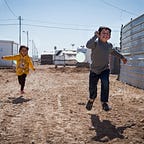Complementary Pathways to Resettlement: Labor Mobility
Refugees are often forced to flee their homes when they lose access to employment opportunities. Upon relocating to often neighboring countries, refugees are faced with challenges of entering the formal labor markets. Within host communities, refugees are either siloed into refugee camps with limited livelihood and economic opportunities or live in urban areas that may only provide opportunities in the informal markets. The lack of employment options can lead refugees to move to a country where better jobs are seemingly available, however, there are many barriers in re-locating such as acquiring proper documentation of passports, visas, and work permits. The complementary pathway of labor mobility is when refugees and other displaced people are able to resettle through established employment opportunities in third countries.
According to the UNHCR, while labor mobility is separate from the formal resettlement process, these opportunities can support refugees in their search for protection and access to formal employment. Labor mobility opportunities amount to a person entering a country through a “safe and regulated” manner in order to pursue employment. Once relocating for an employment opportunity, refugees are able to locally integrate into their host community and become contributing members of the community. Labor mobility can lead to refugees either integrating further into the host country and pursuing formal immigration processes, or they can be used by refugees to acquire professional skills that they can use if they choose to return to their home country once it is a safe option to do so.
Labor mobility policies can complement formal resettlement opportunities and serve as an “expression of global solidarity and international cooperation” to contribute to the protection of refugees and share the responsibility amongst countries. The creation of ethical labor mobility pathways requires the collaboration of various stakeholders across sectors to ensure the protection of refugees. Although barriers to the creation of labor mobility certainly exist, including the lack of political will from national actors and a reluctance to blur the line between “refugees” and “migrants” from humanitarian actors, there are still efforts to create these pathways in various countries.
The Expansion of the Labor Mobility Scheme
According to the International Labor Office, in recent years, some countries have reformed refugee and labor legislation to expand formal employment opportunities to refugees.
Due to the protracted nature of the crisis in Syria, some of the largest hosting countries of Syrian refugees have adopted legislation in their respective countries to include refugees in the formal labor market. Importantly, since refugees are understood to be hosted on average for a decade, it is beneficial for both host countries and the humanitarian and development agencies to promote self-sustaining pathways for refugees, including labor mobility. In 2016, Turkey, host to 3.6 million Syrian refugees, expanded their right to work permits to include Syrian refugees under temporary protection. Similarly, Jordan, host to 1.8 million Syrian refugees, has expanded work permits to refugees to make work beyond the informal economy more accessible for Syrians. Germany, host to half a million Syrian refugees, has also allowed Syrians access to the formal labor market.
Despite expanding the formal markets to include refugees, legislation often comes with limitations to which sectors of employment refugees can enter. Even with the appropriate legislation in place, the majority of refugees may still not have access to employment opportunities, may be discriminated against when seeking employment, or may be underemployed. These challenges present an opportunity for additional partnerships within the international community to provide more innovative solutions and support to refugees pursuing labor mobility.
How do refugees find opportunities for labor mobility?
While labor mobility schemes typically act as a pathway that refugees can access directly through publicly available information, the international community, as well as country-specific organizations, also assist refugees with finding employment.
For example, the UNHCR partners with a civil society group, Talent Beyond Boundaries, whose mission is to unlock skilled migration pathways for refugees. Through a partnership with Canada, the United Kingdom, and Australia, Talent Beyond Boundaries connects employers with refugees through an online platform in order to provide a mutually beneficial employment opportunity. The organization recognizes that despite barriers of documentation, many refugees are highly-skilled workers who have the wealth of talent to contribute meaningfully to the community they live in or resettle to, and should have the opportunities to do so. This short video showcases Syrian refugees who have benefited from Talent Beyond Boundaries.
Country-specific organizations have also created initiatives meant to provide assistance to refugees seeking employment. The Lutheran Immigration and Refugee Services (LIRS) have a Refugee Youth Career Pathways program in the United States. The program serves as professional development mentorship for refugee youth (ages 16–24), helping the youth build professional skills and access opportunities for employment in the United States. LIRS also provides training programs and English language classes to further advance the refugee’s skills and ability to find sustainable employment.
Refugee Pathways is committed to complementary pathways which ensure the relocation and protection of refugees. Labor mobility schemes serve as one of these complementary pathways that allow refugees to safely relocate and pursue livelihoods around the world.
By Emily Ervin for Refugee Pathways
